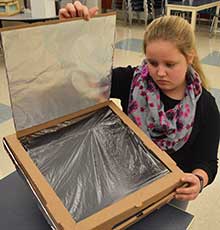A group of middle schoolers formed a circle on the lab floor, while others leapt onto desks to avoid the trajectory of Beyblades — spinning tops activated by a pull cord — as students competed for whose would spin the longest.
Some blades collided with table legs and skidded to a halt; others found their way safely beneath desks where they spun for several minutes.
In CurtGerber’s sixth-grade science classroom at Kent City Middle School, students are learning the principles of energy transfer by building projects and conducting experiments.
“Energy never actually disappears,” Gerber tells his students. “It just transfers from one thing to another.”

The Beyblade competition demonstrates the transfer of potential energy to kinetic energy. Students learn why the blades stop, and why energy is not lost, but transferred.
The students also put their understanding of energy transference to the test by selecting a project to build: an icebox, a catapult or a solar cooker.
Jack Mitchell said his icebox, built from foam and scraps of space blanket, kept a single ice cube cold for most of the four-hour requirement. Jack isn’t new to building things, he said, or taking them apart.
“Whenever my dad has something and he’s going to throw it away, I’ll just take it apart and take the parts out,” Jack said.
Jack recently gutted a light fixture to remove the pull cord and the chip boards, just to see how they fit together.

Science Breeds Ingenuity
Wesley Wheeler said his catapult launched a bouncy ball an average of 3 meters, using three rubber bands to pull the arm back.
“My grandpa was a carpenter,” Wesley said. “When he was younger, a mechanic. He had a design. We went from there.”
The catapults lining the classroom range from palm-sized to several feet tall, involving different kinds of household and construction materials. Wesley’s is made mostly from wood, held together with wood glue and nails.
“You can clearly see that it’s unique to its own style,” Wesley said. “You’re the one with the materials. You’re the one with the style that you want it to be.”
Makenna Neumen hasn’t had an opportunity to test her solar cooker yet. It requires intense sunlight, but the project is ready for spring, when she hopes the sun’s radiation will help cook a marshmallow, or maybe a hotdog.
“I do crafting,” said Makenna, lifting the lid of a cardboard pizza box to reveal its tinfoil and black paper layers. “I had all of these materials already. It was pretty easy to put together.”
Gerber said the projects provide a practical lesson, but also a memory that sticks.
“One of the biggest things for me is just doing the project,” he said. “I have some of these projects sitting in my room from years past. Kids are always asking me about them: ‘When do we do this? When do we do that?'”
While some iceboxes, for example, lacked the insulation to keep ice cubes cold, others featured small, insular chambers for the ice cubes to thrive. But even projects that don’t fling bouncy balls the farthest or cook marshmallows to gooey perfection are a learning opportunity, Gerber explained.
“When they build one that works properly, it shows that they have some level of understanding that can hopefully be another avenue of learning.”
CONNECT









